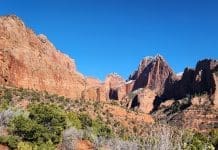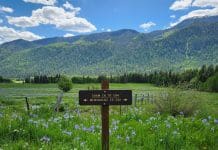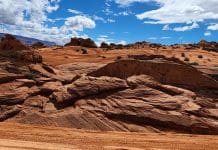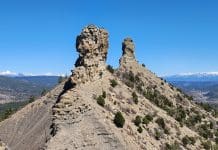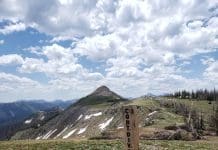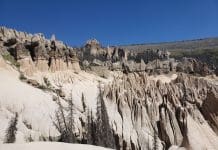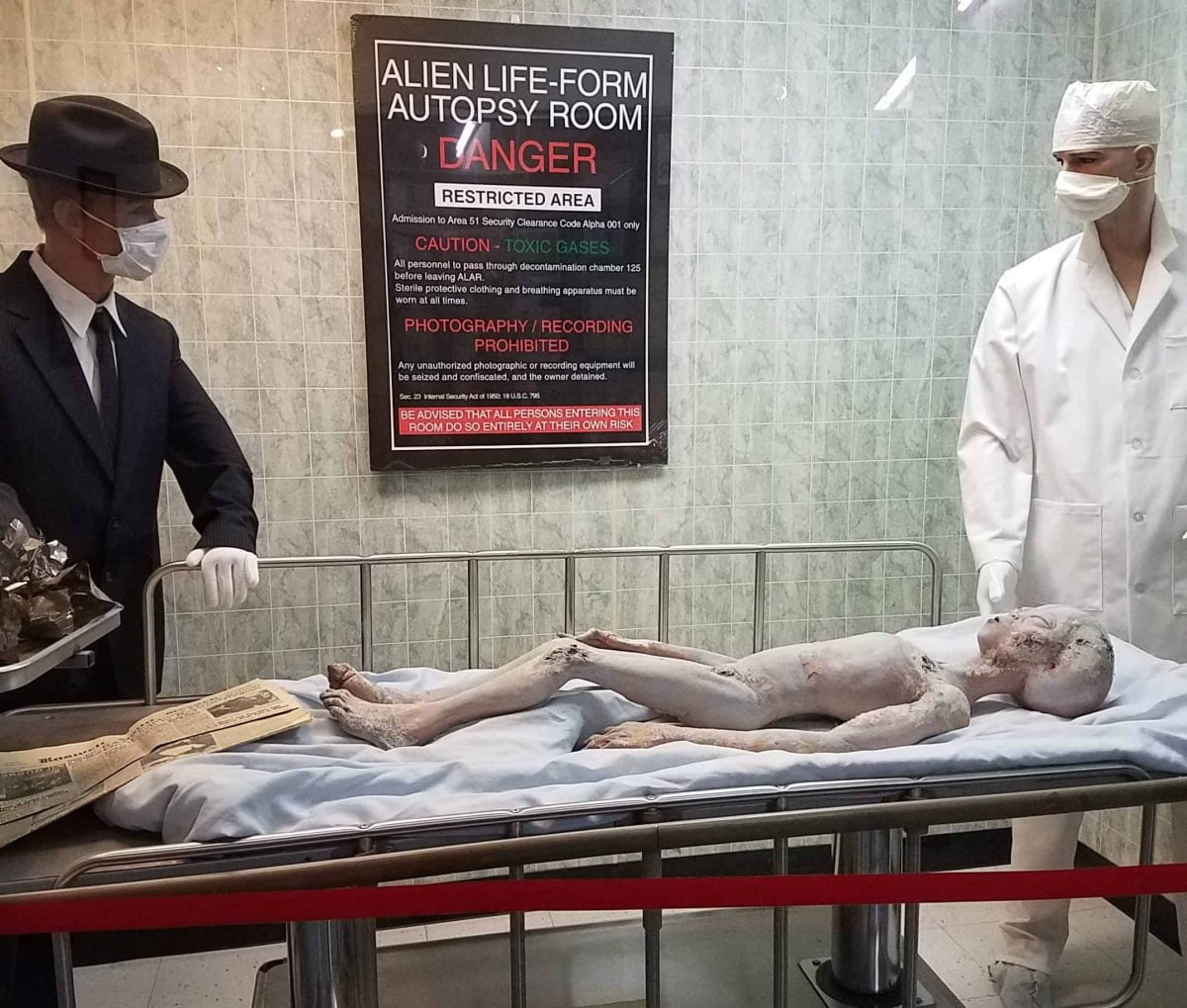Perhaps the most famous of the wild mustangs in the United States — the Pryor Mountain wild horses — are located about an hour and a half from the east entrance of Yellowstone National Park in the Pryor Mountain Wild Horse Range (also known as the Pryor Mountains Wild Horse Range.) We were RV camping in the area and decided to take a detour to visit the horses.
This remote and rugged landscape is home to a unique population of wild horses that have roamed these mountains for centuries.
You can take a tour to visit the horses or if you have four-wheel drive, you can drive yourself up a mountain to see them.
We drove to visit these beautiful mustangs and saw about 30 of the approximately 150 mustangs living on the range.
Details about the wild horse range and step-by-step driving instructions are provided below.
We also provide suggestions for RV camping options in the area, including campgrounds and dispersed camping locations.

- History of the Pryor Mountain Wild Horse Range
- Location
- The Wild Horse Population
- Pryor Mountain Wild Horse Range’s Landscape
- Documentary on the Pryor Mountain Horses
- Pryor Mountain Wild Mustang Visitor Center
- BLM Pryor Mountain Wild Horse Range Map
- Directions to the Pryor Mountain Horse Range
- Directions to the Mountain Meadows from Lovell, Wyoming
- Penn’s Cabin
- How to Behave Around Wild Horses
- Return Trip Down the Mountain
- Future Preservation of the Pryor Mountain Wild Horse Range
- RV Camping Options near the Pryor Mountain Wild Horse Range
- Final Thoughts about the Pryor Mountain Wild Horse Range
History of the Pryor Mountain Wild Horse Range
The Pryor Mountain Wild Horse Range is situated in the Pryor Mountains, a subset of the Bighorn Mountains in Wyoming.
These mountains are of great historical and cultural importance to various Native American tribes, including the Crow and Cheyenne.
The current wild horse population in the area is descended from horses brought to North America by Spanish conquistadors in the 16th century, serving as living symbols of our nation’s history.
Established in 1968, the Pryor Mountain Wild Horse Range holds the distinction of being the first public wild horse range in the USA. It is one of only four officially designated ranges in the United States, primarily focused on the management of wild horses and burros.
You may also be interested in visiting the USFS Jicarilla Wild Horse Territory which is very near where we camped at the USFS Cedar Springs Campground in northern New Mexico.
Location
The Range spans the border between Wyoming and Montana, covering almost 40,000 acres of Bureau of Land Management (BLM), National Park Service (NPS), United States Forest Service (USFS), and private lands.
To put it in perspective, that’s about 62 square miles, without factoring in changes in topography.
Found in the southeastern part of Carbon County, Montana, and the northern area of Big Horn County, Wyoming, the Pryor Mountain Wild Horse Range is roughly 50 miles south of Billings, Montana, and a mere 10 miles north of Lovell, Wyoming.
We visited the horses during a trip to Devils Tower National Monument in Wyoming where we stated at the base of Devils Tower at the Belle Fourche River Campground.
Pryor Mountain Wild Horse Range Map
The Google map below shows the exact location. Click on the map to enlarge it and find driving directions.
The Wild Horse Population
The Pryor Mountain Wild Horse Range houses a unique group of wild horses known as mustangs. These mustangs descend from once-domesticated horses that have adapted to a wild lifestyle. They roam freely across rugged mountain and desert landscapes.
These horses trace back to those brought to the Americas, establishing a wild population in their mountainous home for nearly two centuries.
The Pryor Mountain mustangs are distinct from other American mustangs because of their genetic heritage. It clearly connects them to the colonial Spanish horses of the Conquistadors.
This lineage has been preserved, setting them apart from other U.S. wild horses that have mixed with domestic breeds. As a result, they are among the most genetically significant wild horse herds in the U.S.
These horses stand about 14 hands tall and show traits of the original Conquistador horses, including a natural paso gait. This gait is unique to certain Spanish horse breeds.

These horses display a range of coat colors like grays, bays, blacks, and roans. They form social groups led by stallions, which include mares and their foals.
Mustang Families
Wild horses typically form bands of approximately five or six horses, with a dominant stallion, a lead mare, and several other mares and young horses, including the young offspring of the mares.
In the Pryor Mountain mustang herd, researchers counted 157 horses in 28 family bands. The two largest horse bands in 2017 each had 10 horses.
There are also some horses that are alone most of the time, choosing not to participate in a band of horses for one reason or another.

In addition to the family bands including a stallion and mares, there are also bands of bachelor stallions, who are always ready to spar with one another and challenge the lead stallion of bands for the mares.
These can make for interesting sights to see as the bachelor stallions often rear up as they challenge one another.
We were lucky enough to witness one of these encounters between two stallions as we drove up to the top of the mountain.




These horses are known for their strength and stamina, making their home in the tough, high-elevation areas. They’ve adapted to the challenging conditions, a true sign of their toughness.
Pryor Mountain Wild Horse Range’s Landscape
The Pryor Mountain Wild Horse Range features a complex ecosystem. It stretches across elevations from 3,850 to 8,750 feet above sea level.
This elevation range leads to varied yearly rainfall. It rains as little as 6 inches in lower regions to over 20 inches in the higher, alpine areas. Water is quite rare here.
The area hosts diverse plant life, including shrub-grass areas with sagebrush, saltbush, and wheatgrasses, and wooded zones filled with Douglas-fir, lodgepole pine, and juniper.
It’s also home to other wildlife like mule deer, bighorn sheep, black bears, rattlesnakes, and mountain lions.

Documentary on the Pryor Mountain Horses
The Pryor Mountain wild horses were the subject of a 1995 documentary film by Emmy-winning filmmaker Ginger Kathrens called Cloud: Wild Stallion of the Rockies.
In 2003, she filmed a sequel documentary film called Cloud’s Legacy: The Wild Stallion Returns. The films focus on Cloud, a beautiful white stallion whose life from birth is chronicled in these wild horse films.
In addition, Ginger Kathrens published a beautiful book called The Wild Stallion of the Rockies that retells her years following the wild horse herd on the Pryor Mountain Wild Horse Range.
The book is elaborately photographed and divided into 17 chapters that follow the life of Cloud, the beautiful white stallion that lives in this wild horse herd.
The book begins with the author and filmmaker witnessing the birth of the white colt, and follows with chapters that tell the story of his interactions with his mare Raven and and his brother Diamond, as well as the other horses in the wild mustang herd in Montana.
It tells a beautiful story of life as a wild horse that any horse lover will enjoy reading.
Pryor Mountain Wild Mustang Visitor Center
Before we headed up the mountain to see the wild horses, we stopped by the Pryor Mountain Wild Mustang Center in Lovell, Wyoming.
Founded in 2004, the Pryor Mountain Wild Mustang Center is a nonprofit focused on teaching people about and protecting this special herd of wild horses.
As the main supporter of the Pryor wild mustangs, the Center works closely with the BLM and the National Park Service to keep the mustangs safe.
They run educational programs, do advocacy work, and conduct research to help ensure the wild horses keep thriving for years to come.
Plus, they give visitors a chance to watch the horses in their natural setting, offering a closer look at these extraordinary animals.

The Center offers visitors with information from the leading experts about this mustang herd. The Center has maps, books, and souvenirs such as hats and t-shirts.

The Center also provides details about recent horse sightings on the range so that visitors can know where to go to find the horses and tips for understanding their behavior.

When we stopped by, the helpful staff provided a map and outlined where we should go to have the best chance of viewing the horses.
Pryor Mountain Wild Horse Tours
The Pryor Mountain Wild Mustang Center offers tours to individuals and groups to see the wild horses.
If you do not have an appropriate 4-wheel drive vehicle, then it is recommended to take a tour with these committed mustang experts.
They offer tours between May and October of each year. In 2024, the tour price per person is $240/person. Contact the Pryor Mountain Wild Mustang Center for more information about the tours they offer.
If you have your own 4-wheel drive vehicle and want to drive to the range yourself, see below for the driving directions to the Pryor Mountain Horse Range.
If you’re not able to travel into the Pryor Mountain Wild Horse Range to see the horses, the Pryor Mountain Wild Mustang Center has several adopted Pryor Mountain mustangs at the Center that you can visit.

BLM Pryor Mountain Wild Horse Range Map
The BLM also provides a brochure with a map that you can download from their website. It has two pages, shown below.


Directions to the Pryor Mountain Horse Range
If you decide to travel to the wild horse range on your own, instead of taking a tour, it’s important to know where to find the wild horses so that you don’t spend hours driving in the 40,000 acres without spotting a mustang.
40,000 acres is a lot of land to cover to see a herd of approximately 150 wild horses that are not all in one place.
The bands of horses typically stay away from one another, but in the summer months, they are more likely to be in the same area as they head up to the cooler 8,700+ feet in elevation areas of the East Pryor Mountain range.
This area has grassy mountain meadows that attract nearly half of the herd of 150+ wild mustangs in the summer. It is the best place to see the wild horses in the summer months, when most people are likely to visit the Pryor Mountain Wild Horse Range.
Getting There Requires 4 Wheel Drive
If you visit in the summer months and are likely to be driving to the top of Pryor Mountain to see the horses in the mountain meadows, then you MUST have an appropriate four-wheel drive vehicle.
Do not ignore this.
We drove up in an F-350 pickup truck with high clearance and four-wheel drive, which was fine. However, we would have been better suited in a smaller 4×4 vehicle with a shorter wheel base in order to maneuver the corners and rocks.

The staff at the Pryor Mountain Wild Mustang Center told us of many horror stories of cars being stuck on the range while trying to access the mountain meadows.
The situation is further complicated because part of the wild horse range lies in Wyoming, with the majority in Montana. Tow trucks need state approval for where they operate. So, where a tow truck is licensed—whether in Wyoming or Montana—really matters.
So a word of advice from someone used to taking risks with these sorts of things…. don’t plan to drive up the mountain range unless you have an appropriate 4×4 vehicle with a high clearance for passing over obstacles in the road.
You also need to have some sort of aftermarket all terrain tires on your vehicle rather than the stock tires from the dealership. There are many signs throughout the range stating this as well, with good reason.
Despite what some of the photos in this post may indicate, the road is not always smooth and easily passable. If you drive in a regular passenger car, you are likely to get stuck in this remote area.
Directions to the Mountain Meadows from Lovell, Wyoming
If you’re visiting the mustangs in the summer months, a majority of the horses are likely to be congregated high up in the mountain meadows. This requires a drive of about 15 miles up dirt roads and rocky roads that require four wheel drive.
The elevation changes from about 3,600 in the lowlands to nearly 9,000 feet in the mountain meadows. Plan to drive two to three hours to get to the top of the mountain range and about an hour or two to get back down after visiting with the horses.
To access the mountain meadows of East Pryor Mountain where many of the horses are in the summer months, you will being in an arid high desert lowland area and ascend to a fir and pine covered mountain area with grassy meadows.
Driving Directions
From Lovell, Wyoming, take US 14A for 2.4 miles east of the town of Lovell. Turn north onto State Highway 37 and drive 9 miles.

You will see a small white building on your left about 100 yards from Highway 37, as shown below. You can’t miss it as it’s the only structure in the area.

There is a sign there for the Crooked Creek Road on the left.

Turn left onto the Crooked Creek Road. Go 1.7 miles west on Crooked Creek Road. At this point, the road is a standard gravel road that is fairly smooth and easily drivable by any passenger car.

Continue following the signs for the Pryor Mountain Wild Horse Range and for the Burnt Timber Ridge Road (BLM Road 1018).
The roads are well marked and easy to follow. There are signs at every turn so it is not easy to get lost.

High Desert Section
You will start in high desert terrain and an easy gravel road.
From there, you will progress upward in elevation and the road will become increasingly technical and challenging for vehicles.

As you move higher up the elevation, the terrain will change to a red colored dirt with outcroppings.



Once you enter the Pryor Mountains, the road will become a little rougher.

You will continue climbing up the mountain and will come to an area known as the table top.
We were originally a little lost as we came upon a picnic table and it appeared the road ended.

However, the road had not ended. Instead we’d come to a “roundabout” of sorts and the road continues on.
There is a trail leading from the picnic table, but that is not the road. Keep looking in the “roundabout” area and you’ll see the road leading to the left.

Four Wheel Drive Needed From Here On
You’ll also notice signs warning motorists of the need for four wheel drive vehicles. Take heed of them.

The road continues on up the mountain.

As you progress up the mountain, you’ll notice that the terrain changes.
You’ll start entering areas with more grass and less of a desert feel. You’ll think you’re near the top. You aren’t. Sorry! Keep driving up the mountain.
You’ll likely start to notice horse poop scattered around. This is evidence that you’re headed in the right direction.
If you’re lucky, you’ll see a mustang or two in this area, but your destination is still a ways to go.
Next you’ll encounter wooded areas. You’ll drive over some rough road and keep climbing. You’re getting there.

Seeing the Horses
Once you pass through the wooded areas, you’ll enter grassy meadows. You’ll likely start to see the Pryor Mountain wild horses in this area.

This is where you want to be. It will start to look like the photo below and you may see a few mustangs.





Keep going until you see signs for Penn’s cabin.

At this point, you’ll be near the top of the East Pryor Mountain.
This is where a large number of the Pryor mustangs are in the summer months as the grass in the mountain meadows is plentiful.
Penn’s Cabin
Penn’s Cabin is located near the top of the East Pryor Mountain in the Pryor Mountain Wild Horse Range.
It is located right alongside the BLM road on the top of East Pryor Mountain so you are unlikely to miss it.
A man nicknamed Penn built the cabin in about 1925. The BLM has repaired the cabin and it is open for campers’ use.

The cabin has a wood-burning stove to help keep campers warm. When we visited, the cabin had a pile of wood stored there for burning in the wood stove.

View of the Mustangs from Penn’s Cabin Meadow Area
Drive up to Penn’s cabin, park the car, and enjoy your view of the wild horses. We saw about 30 mustangs up in the mountain meadow area. We parked our truck and enjoyed the view.






How to Behave Around Wild Horses
The Pryor Mountain Wild Horse Range is home to wild mustangs. They are unpredictable and not domesticated.
While these horses may be somewhat accustomed to humans they are far from tame.
To ensure the safety of both the horses and visitors, the BLM urges a minimum distance of 100 feet from the horses. Avoid attracting their attention by refraining from shouting or honking your car horn.
If a horse reacts to your actions, you’re likely too close or engaging in inappropriate behavior. Please adhere to the BLM behavior guidelines to keep the horses safe.
Return Trip Down the Mountain
To return home, go back the same way you came.
Do not attempt to go down Sykes Ridge Road as it is a very technical and challenging 4×4 road. It is not passable by most vehicles, even those with four-wheel drive.

Future Preservation of the Pryor Mountain Wild Horse Range
The Pryor Mountain Wild Horse Range stands as a symbol of American heritage. Yet, the wild horses there encounter many obstacles.
Arid land and limited food put pressure on the horses, a situation that worsens with the increasing frequency of dry years in the West.
Fortunately, groups like the Pryor Mountain Wild Mustang Visitor Center are joining forces to safeguard the horses’ future. They employ methods like fertility control and selective removal to ensure the ecosystem remains stable.
RV Camping Options near the Pryor Mountain Wild Horse Range
The Bighorn Canyon National Recreation Area is located southeast of the wild horse range.
It is a good starting point for when you are looking for locations for camping.
RV Campgrounds
- Sage Creek Campground: The United States Forest Service operates the only campground in the Pryor Mountains. It is operated by the Beartooth Ranger District and has 12 campsites, with a max RV length of 30 feet. There are no hookups, but vault toilets are available. It is first-come, first-served.
- Barry’s Landing & Trail Creek Campground: Located in the Bighorn Canyon National Recreation Area and operated by the National Park Service, this campground is open year round. It is $18 per night (as of November 2023), and has 14 RV campsites, which fit smaller RVs (up to 28 feet long). There are vault toilets only, with no running water or electricity available.
- Horseshoe Bend Campground: This campground is also located in the Bighorn Canyon National Recreation Area. It has 28 campsites for RVs which are operated by the National Park Service. These sites have water and electrical hookups. There are also 3 pull through sites for large RVs. Modern restrooms and drinking water is available. An RV dump station is also available. Reservations for 10 campsites can be made through the Horseshoe Bend Marina.
Dispersed Camping
Both BLM and USFS offer dispersed camping options in the area of the Pryor Mountains. To find locations, use our step-by-step instructions for identifying USFS dispersed camping locations using the USFS free mapping tools.
Final Thoughts about the Pryor Mountain Wild Horse Range
Visiting the wild horses on Pryor Mountain is an awe-inspiring experience.
Seeing the wild horses is a moving experience. It is very different from visiting a dude ranch, but we also enjoyed our experience at a dude ranch RV camping in our Airstream in Montana.
Make sure to enjoy your visit, but remember to follow the guidelines for interacting with the mustangs. Following these rules is crucial for the safety of both you and the wild horses!

